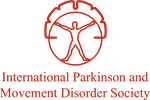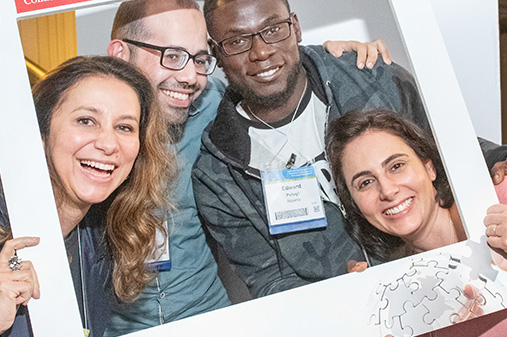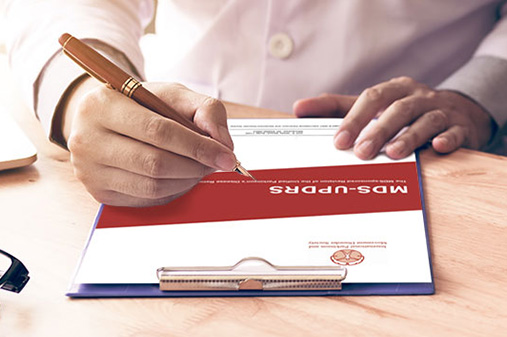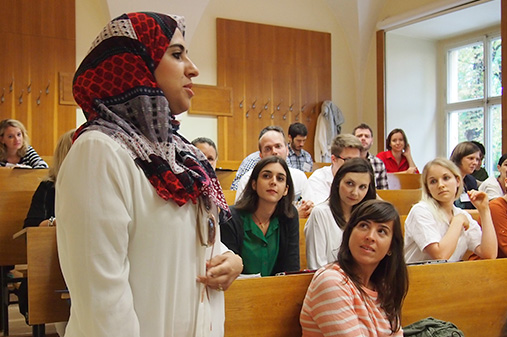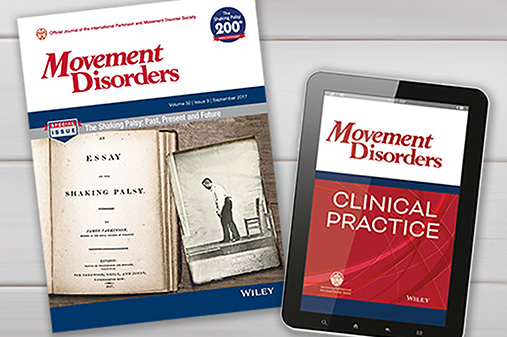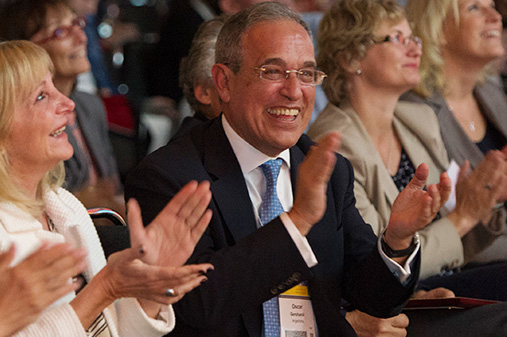Tremor Series: What’s essential tremor?
[00:00:05] Dr. Alfonso Fasano: Hello, and welcome to the MDS podcast, the official podcast of the International Parkinson and Movement Disorder Society. I'm Alfonso Fasano, professor of neurology at University of Toronto in Canada, and I'm the guest editor for this new special series on tremor. Today, we have a very special topic and very special guests that I'm honored to interview.
Today, we have Professor Deuschl from University of Kiel and Professor Bhatia from University College of London in the UK. And here with us these giants in the tremor research are to discuss the topic. What's essential tremors? What's essential tremor is the title of this episode. And first of all, I want to thank the speakers for having accepted to be with us today.
View complete transcript
Thank you.
[00:00:50] Prof. Kailash Bhatia: Good morning Alfonso, and thank you for inviting us on this
[00:00:54] Dr. Alfonso Fasano: Okay so, I decided to invite you both at the same time, because you've been the soul of the [00:01:00] new classification of tremor that came up, I believe, in 2018, and you're respectfully the 1st and senior author of that publication. And I know that publication took a while to be completed and several discussions amongst the different experts.
So first of all, before we get into the topic of essential tremor I would like to ask you one question. I'll ask the same question to both of you so that you both have the time to, to answer. Starting from Professor Bhatia, I would like to ask you, what do you like of the new classification?
[00:01:33] Prof. Kailash Bhatia: Yeah, I think what I like about the new classification mainly is that the plea for my side was that we consider essential tremor as a syndrome. And that is what has been effectively brought out in this new classification. Because the previous classification, although they were good, lot of people used to think about essential tremor.
As one discrete [00:02:00] entity, and they would think about essential tremor as a disease, as one disease or one disorder. And I think the main input we have given with this is to highlight or bring out the fact that essential tremor is a syndrome and not one disease.
[00:02:18] Dr. Alfonso Fasano: Okay, thank you and the same question to Professor Deuschl was the first author of the first classification of tremor. It came up years ago, 1996, if I'm not mistaken. What do you like about the new classification?
[00:02:31] Prof. Guenther Deuschl: Similar as Professor Bhatia I think it has opened a little bit the the description of what essential tremor is. I think every neurologist knows that it is a complicated definition. It is very simple in terms of what the inclusion criteria are but in, in essence, whether we really capture always the same kind of disease with this is very much in question.[00:03:00]
And what we did is really to ask people to describe what they see, what they think, what under this diagnosis is meant to be essential tremor. And I think that's the progress of of this part of the classification.
[00:03:15] Dr. Alfonso Fasano: Thank you now, a question for you directly, because I want to alternate between the the answers pretty much like the presidential debate. And the question is, what don't you like about the new classification?
[00:03:39] Prof. Guenther Deuschl: Is is essential. Is is itself a diagnosis which is, has never been intended like this. It clearly says, describe what you see and what, we have defined this term essential tremor plus just to encourage people. to really describe what they see. It is one of [00:04:00] the most important problems of the past 20 years that people simply say it's all essential tremor and they don't describe what they see.
There are subtle symptoms that separate one patient from the other. And and yeah, a misunderstanding of that means that they don't understand the core of the definition.
[00:04:20] Dr. Alfonso Fasano: Thank you. Same question to you, Professor Bhatia.
[00:04:24] Prof. Kailash Bhatia: I totally agree with Guenther. I completely agree. I think one of the issues which, there has been a lot of criticism. Also by you and others about this essential tremor plus idea. And I think the reason for that, as Guenther points out, people are not understanding perhaps maybe it's a fault on our side or not.
But I think the idea, the concept here using axis 1 and axis 2. Because clinically what you perceive is on axis one and then to make people understand that on axis one You describe the syndrome what you're [00:05:00] seeing and if it is pure as essential tremor syndrome should be or is it combined?
With other features, but maybe not strong enough features to say that it is definitely dystonic tremor or cerebellar tremor This is what happens in life That in, pragmatically, what we are seeing in our people is what you can describe. You cannot evoke or think about the future as to what this particular patient might be in the future.
You have to describe what at the moment. And I feel that. This classification, as Guenther has mentioned, giving you this possibility of being able to describe and put in as many patients as you can in these two categories, which will cover a lot of our patients, which we see is really the strength of this rather than what you may say is a bad side of it.
But I do agree with Guenther that people, particularly people who are maybe not in the field It may be difficult for them to get the concept, but if they can [00:06:00] understand it, then I think it's really a good classification from a pragmatic point of view, from a day to day use point of view, because that's what you would do as a clinician.
You have to describe what you see, and this classification helps you do that.
[00:06:14] Dr. Alfonso Fasano: Very good. Thank you. Now, let's talk about a very practical situation. So let's imagine you are in your clinic and there is this gentleman that comes to see you for the first time we can call him Mr. Smith. And Mr. Smith has a little action tremor, mainly during kinetic maneuvers, a little bit on posture, nothing else no rest tremor, of course, just an action tremor is quite what type of tremor has been there for about four or five years.
Is sixty years old, and this tremor affects symmetrically both hands. There are not many other signs, including the famous soft signs. Maybe there's a little posturing when he's holding a posture, but you wonder whether this is just because he's learned to do that to reduce the [00:07:00] amplitude of the tremors, more of a compensatory maneuver.
So that's the clinical picture. So let's start with Professor Bhatia. So this man, Mr. Smith, asked you. Okay, doctor, what do I have? What's my diagnosis? What will you tell this patient?
[00:07:14] Prof. Kailash Bhatia: So again, we are talking about pragmatically, practically, okay. So for me, the main component is that, as you said, bilateral, largely symmetrical, postural kinetic tremor he would fall into the essential tremor, syndrome category.
Okay. Now I have noted the mild, as you said, a mild posture abnormality. If I was thinking about doing some research studies in him, I would put him in the essential tremor plus category. If I'm sure that this abnormal posture, I don't think we need to get into the issue about, is he doing that because of compensation?
How do you know? You don't know that. You have to go by what you see. If you've seen that there is an abnormal posture but maybe not enough to say this is definitely [00:08:00] dystonia, he goes into the essential tremor plus for me from my research point of view.
But for him, I would say you fall into this family of what we call essential tremor syndrome. That's it. It's simple as that.
[00:08:12] Dr. Alfonso Fasano: Yeah, I wasn't expecting for a complex answer and also because this is supposed to be the answer to give to a lay person like a patient. So Prof. Deuschl, same question to you. Same clinical scenario. What would you say?
[00:08:26] Prof. Guenther Deuschl: The same simply.
[00:08:30] Dr. Alfonso Fasano: Perfect.
[00:08:31] Prof. Guenther Deuschl: there's not much to add I would do some laboratory tests. I would look for thyroid function. I would ask him exactly when it started, if there was anything in the beginning. If he's suffering from any other disease, I would ask for his age and a number of things.
But essentially this is exactly what I would do, what Kailash has just mentioned.
[00:08:53] Dr. Alfonso Fasano: Okay, so let's say with you, after a day, you get a phone call from the son of this patient who [00:09:00] happens to be an academic gastroenterologist working in your same institution. Very active in research, of course, a physician, not a neurologist, but still very interested in research and tells you I know you met my dad yesterday, told me that you said is essential tremor.
We feel relieved about that. Thank you for seeing him. But can you tell me what do you think is going on? What is this?
[00:09:23] Prof. Guenther Deuschl: I would involve him into the discussion on essential tremor and age related tremor or tremor of the aging persons because it's very common if his dad is changing from 60 to 70, that the likelihood to develop tremor is increasing. And we don't know exactly whether this is the same as the tremor that you can see.
In childhood or during early years at midlife. That is still an open question. And I would tell him, this is a syndrome and perhaps the nervous [00:10:00] system has many ways to answer to noxious conditions of all kinds, including aging processes.
And one of them is to develop the tremor and we don't know about the details here and we will simply have to go ahead with where we are.
[00:10:17] Prof. Kailash Bhatia: Yeah. So I think that, so what I would say to a person who's a, as you said, a researcher or a scientist himself, I would try and explain to him that essential tremor is a syndrome and that it's a moving target. So we can only go by what we see now. We would say, like Guenther said, we've excluded other things like drugs or, any other causes of what might be causing his tremor, thyroid function, et cetera, et cetera.
And then we come to this concept about the tremors which happen in people with age, et cetera. We don't know. We call it idiopathic. We don't know the cause at the moment. And that's why it's called an idiopathic entity, but on axis two, [00:11:00] there may be certain causes and as time goes on, now let's see that little posturing which we have developed, which we have noticed is developed further.
He's become a dystonic tremor. Maybe there's a family history which comes out. And at that time, we might consider doing some genetic tests on him. To explain to him. So that's only to a research oriented person. If the person was, as you said, a ordinary, or if I were, I don't want to use the word ordinary in a, in a sort of a derogatory manner, and I'm saying from my practical point of view, I would say you have a condition which is a very common condition, and this causes tremor, and essentially this is the sort of tremor it causes.
We don't know the cause of this. There are many causes. Some of them we have already identified and removed and in your condition, we either call it primary or idiopathic. That's it.
[00:11:53] Dr. Alfonso Fasano: Perfect, so thank you for the answer and I can see there. You're pretty much aligned here on even on this one, but then continuing [00:12:00] with the phone call and this is for you. Prof. Bhatia,, the son says, Oh, thank you. This explains a lot and I appreciate it. They said originating. We don't really understand.
What's going to happen in the future it's hard to predict but I don't know if he told you because this is something that he's not aware of. My mom is telling me that at night and it's been about six, seven years when he sleeps, and he dreams, he moves and he screams and he acts up his dream.
Is this going to change anything? Do you need this information? Oh
[00:12:29] Prof. Kailash Bhatia: Well, again, we have to say what we see, what we go by. Because this person is into inverted commas, educated in certain ways, I would say to him that we know that this could be what we call REM sleep behavior disorder. And that has been associated with people with Parkinson's disease.
It doesn't matter whether they had essential tremor or they didn't have essential tremor. This is true for people in general. So if you're describing what we think is RBD, there is a [00:13:00] possibility that in the future these people have a higher risk of turning into Parkinson's disease. Now whether this tremor which he has now is connected to that or not, I cannot say.
That is not going to change my diagnosis to tell him that this tremor which I'm observing in you, which I've called essential tremor, is actually a Parkinsonian tremor. It could be, but I cannot say that for sure. This idea about the RBD is true for Parkinson's disease, not for tremor as a risk factor.
Prof. Deuschl,
[00:13:31] Dr. Alfonso Fasano: anything to add.
[00:13:32] Prof. Guenther Deuschl: If it has happened once, I wouldn't care. If it's happening since eight years that he has these episodes frequently, once a month or twice a month, Then I would really consider that. It has no consequences. At the moment, we will observe this patient and check whether the RBD needs special treatment, whether It needs to be treated with the appropriate [00:14:00] medication for that condition, but not for tremor.
That will not help tremor. If it is really, which can of course happen, if it's really early Parkinson's disease, one of the first symptoms, I think it's very important that during the initial phase of Parkinson's disease, it is not uncommon. that they have tremors, which very much resemble essential tremor.
There are people who say this is because essential tremor is the first sign of Parkinson's disease, but this is not true. This is a Parkinsonian tremor, a very early Parkinsonian tremor and should not be mixed up with what we call essential tremor. But that, that depends on the severity.
If it's only tremor, I would say come back in, in three months and we have a look at it. And otherwise if there's a research perspective that I would certainly do DAT scan
[00:14:57] Prof. Kailash Bhatia: I think I would like to add I completely agree with Guenther [00:15:00] because at the moment we do not have disease modifying conditions, okay? So there are two, two issues here, which are linked, but they are not completely linked. One issue is if he doesn't have bradykinesia and all he has is a, into inverted commas, an essential tremor syndrome, am I going to say you've got Parkinson's disease?
No, not at this time. Okay. But if I had a disease modifying agent and the same scenario was to happen to, like you just mentioned, then I would certainly say, listen, if he has REM sleep behavior disorder, this is a person I might want to consider doing a DAT scan
and then consider giving him the disease modifying therapy having discussed this.
But, at this time and moment when it doesn't have a clinical implication for me to treat, am I going to treat his tremor with a levodopa? No. So I'm going to say to him, this looks like essential tremor. There are [00:16:00] people who have RBD that who in the future may go on to develop Parkinson's.
At this time, I don't see any signs of Parkinson's in your father. I only see the essential tremor syndrome. And whether he will go on to develop this or not, we would keep him under watch as as Professor Deuschl said. That would be the fact. And, again, there are so many implications here.
If you are going to start calling people with essential tremor and who have RBD into Parkinson's disease at this point, there are insurance, this, there is, so many different factors. You can't do that. He may not develop into Parkinson's.
[00:16:38] Dr. Alfonso Fasano: thanks for the detailed answer. I need just a very quick answer at this point from you, because I share the same opinions that you have, and I will say most of our listeners will share the same. But then, if I want to ask, and I know that's not that scientific to ask, your gut feeling with respect to this particular person, regardless of what you're going to tell [00:17:00] the son or the patient.
Do you think that this is. The beginning of. Parkinson's. So then, in other words, this tremor is related to Parkinson's. Yes. No. Maybe. What will be your answer?
[00:17:13] Prof. Kailash Bhatia: Maybe.
[00:17:15] Dr. Alfonso Fasano: Maybe for Professor Deuschl as well.
Okay. Understood. The reason I went there is because I also wanted to pick your brain about something that always puzzled me because we all have seen people with Parkinson's that manifest a little bit of action tremor before.
You can actually diagnose Parkinson's on them, and in some cases DAT scan is positive, and probably these are people also with the seeding assay that would be positive, but it's always puzzling back to my question that the criteria for prodromal Parkinson's disease specifically excludes action tremor.
So they take into account anything including instrumental tools, but not tremor. And I would like to know what's your feeling about that. Is it okay to [00:18:00] exclude it? It's because it's too complicated. It should be included. So let's start with Professor Bhatia. I believe.
[00:18:06] Prof. Kailash Bhatia: Again, I think here, there are two things I would say. This issue will change once we have the RT-QuIC synuclein assay set up properly. So there, I might add that to my repertoire. So if I have somebody with an action tremor, in this context of what you were talking about, RPVA, etc.,
and particularly if there was a disease modifying treatment. I don't think it's here is a question about what are you going to classify these people as. The question is about what can you do about it if there is a possibility of doing something we all know that some of these action tremors migrate, in Lancet Neurology paper by Annette Schrag about prodromal this if you see.
People had a tremor, although it was not clear which sort of tremor, 10 years before. That was one of the first things which had happened. But because it was a GP based survey, it wasn't clear [00:19:00] what tremor they had, but that was one of the first things they had, that a tremor had been found in a large number of them even 10 years before.
So we all know that can happen. But the point here is not that. The point here is if you will develop the RT-QuIC synuclein assay properly with the, this or the DAT scan, this might be something you may want to keep in mind when you're seeing these patients at that particular age group because if there is a disease modifying treatment, you don't want to miss them
but if there isn't a disease modifying treatment available. And all he's presenting it with an action tremor. You don't want to start him on levodopa, are you? So at that time, I would say, yeah you have an action tremor, that's it. But if there was a disease modifying therapy, and if you were able to pick these people up with the synuclein assay and a DAT scan, maybe combined then of course, that is definitely people you want to pick up.
[00:19:56] Prof. Guenther Deuschl: It's, It's really interesting. I wanted [00:20:00] to quote the same finding Kailash, the Schrag paper is always for me, the reference paper when it comes prodromal symptoms of Parkinson's disease. And what I would like to add is, There's one situation where I would consider a DAT scan, even with symptoms that are so weak as we are discussing it at the moment, just a pure postural tremor.
And that is when it's unilateral because that happens. I've seen that several times. Usually it's not long until full Parkinson's disease develops then. And we don't have we then don't have disease modifying drugs so far. But starting very early is probably after the LEAP study is really something that we should seriously consider.
The LEAP study has now shown. that even the early starters have less dyskinesia on the long run. So that, that may be an [00:21:00] advantage and in, after discussing that with the patient, I would consider trying then to give him, for example, MAO-B inhibitors or something else to look after this very first symptom of his disease or her disease.
[00:21:14] Prof. Kailash Bhatia: Interesting.
[00:21:15] Dr. Alfonso Fasano: Yeah, I will argue, though, the unilateral per se, won't fulfilled the criteria for essential tremor. From the very beginning, we'll be talking about a different clinical entity altogether. But but I didn't get,
[00:21:26] Prof. Guenther Deuschl: Predominant, predominant on one
[00:21:29] Dr. Alfonso Fasano: Okay, but back to the question of prodromal PD, I just need a yes. No answer. Would you add it to the criteria for PD, because at the moment is not included. Okay.
[00:21:42] Prof. Guenther Deuschl: The criteria are very well validated and I would not change that. But for patient care I would certainly add my impression of the tremor. to what I think about this particular patient.
[00:21:56] Prof. Kailash Bhatia: I would say that if we do get again, [00:22:00] a disease modifying agent. At that time, I might consider changing the criteria to include t remor.
[00:22:07] Prof. Guenther Deuschl: Then we will do it all together within the society and under structured conditions. But I don't make, I don't make private prodromal criteria.
[00:22:19] Dr. Alfonso Fasano: Okay. So now let's we're this has been great so far. And unfortunately, we have very few minutes left. So just for many, very a few final comments or question I have for you. So the first one is very simple again. Yes. No. Would you keep the term essential tremor for the years to come?
So we'll start with Professor Deuschl?
[00:22:39] Prof. Guenther Deuschl: Yes.
[00:22:40] Dr. Alfonso Fasano: Professor Bhatia?
[00:22:41] Prof. Kailash Bhatia: I will say it will die its own death. Like what happened with essential myoclonus. The term has disappeared once
the gene epsilon-sarcoglycan was found. So I think I would agree with Guenther that at the moment, perhaps it's useful to keep it [00:23:00] both for patients and for lay societies, et cetera, to get funding, et cetera, and so on.
But in the future, when it's more clear, it's more genetically defined, it'll be clear who are turning into Parkinson's, et cetera. It will have its own demise, you
[00:23:19] Prof. Guenther Deuschl: There is no hope for the next ten years to find a gene that explains ET reasonably.
Otherwise, we would have
[00:23:25] Prof. Kailash Bhatia: the future, when we say future, the future is very long, maybe not in our future, but, uh,
[00:23:30] Prof. Guenther Deuschl: If we have etiology, everything changes.
[00:23:34] Dr. Alfonso Fasano: And so staying with Professor Bhatia, that's my last question. Let's say we get rid of the term essential tremor, what term would you like to use?
[00:23:41] Prof. Kailash Bhatia: Well it depends on what you find, right? So whatever might be the underlying etiology that we call that,
[00:23:49] Dr. Alfonso Fasano: Okay. So you don't have a term in mind?
[00:23:51] Prof. Kailash Bhatia: No, I don't think it's useful for me to venture into a new term just to replace a term, which I think is already outdated in a [00:24:00] sense.
[00:24:00] Dr. Alfonso Fasano: Professor Deuschl, anything to add?
[00:24:03] Prof. Guenther Deuschl: I'm always puzzling with the fact that it's so age dependent this syndrome and um, I mean, Critchley has in the past always mentioned senile tremor. And I wonder if in 10 years from now we come back in one or the other form to this basic idea that it's something that has to do with age.
[00:24:25] Dr. Alfonso Fasano: Thank you both. This has been a fantastic interview for me. Really honored that I had the chance to ask the question that I will have asked the experts.
So thanks for listening. Thanks for tuning in. Uh, I want to thank again, Professor Deuschl from Kiel in Germany, Professor Bhatia from UCL in London UK for having joined us today in this podcast on Tremor, title of today's episode was What's essential tremor? And I think that for many listeners now, the picture of this complex heterogeneity that we call essential tremor has become much clearer and necessarily agree with you [00:25:00] that the classification has a lot of merits.
And the problem is that a lot of people didn't even read it carefully. They just jumped to the conclusions that it was so confusing and they start criticizing it. But I agree with you both that there are a lot of pros in this classifications. Again, thank you
[00:25:18] Prof. Kailash Bhatia: thank you very much for sharing it so well. And thanks to Guenther. It's
[00:25:21] Prof. Guenther Deuschl: you. Thank you, Alfonso and Kailash. Great to speak to you.
Günther Deuschl, MD PhD
Department of Neurology
UKSH, Christian-Albrechts University Kiel
Kiel, Germany
